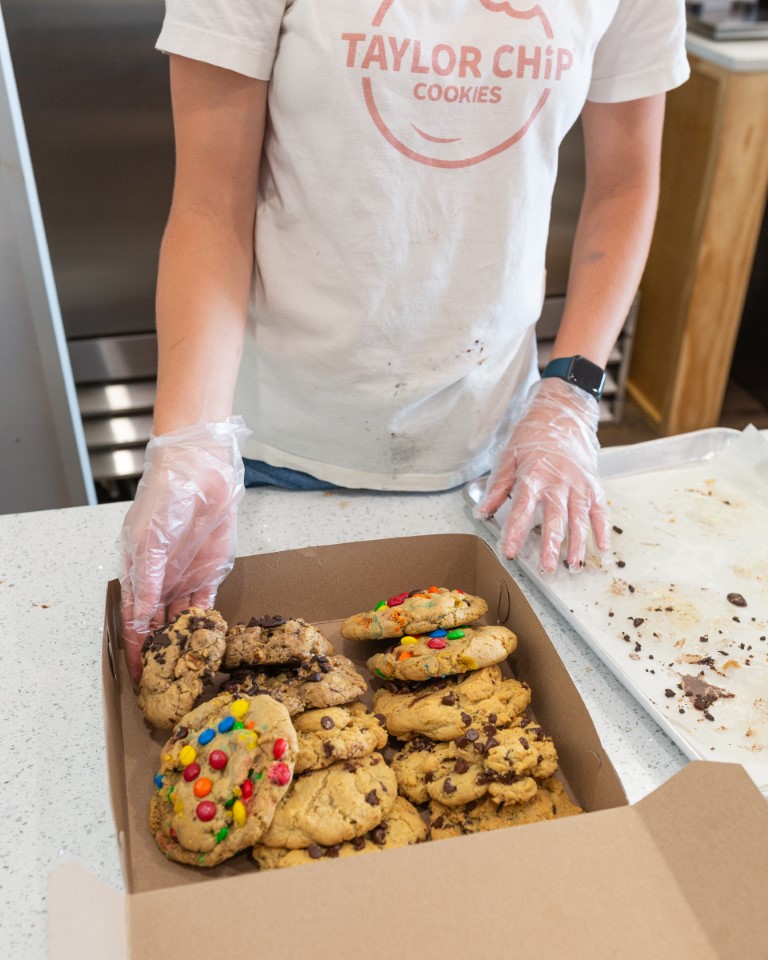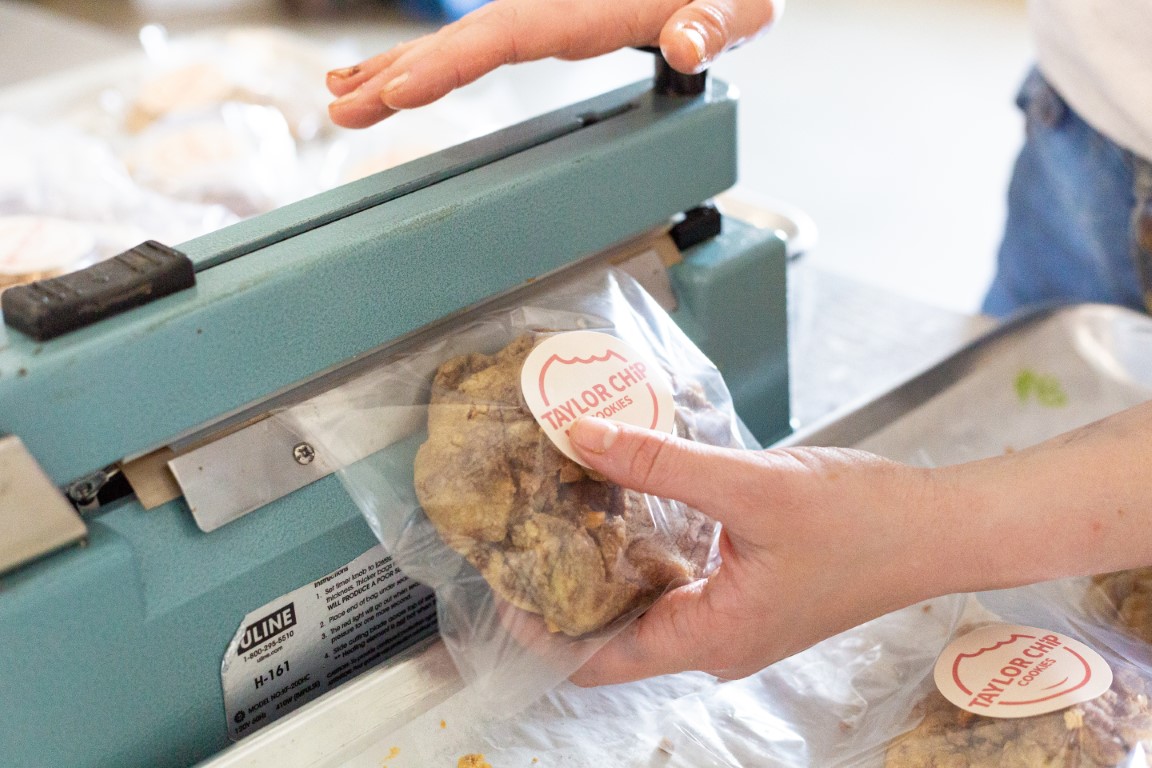To transport cookies with frosting, start by selecting the right type of frosting: royal icing hardens and allows stacking, while buttercream is softer and smudges easily. Crusting buttercream, slightly harder than regular buttercream, offers both durability and taste. Use single-layer containers, sturdy boxes, or heat-sealed bags for packaging. For best results, line containers with bubble wrap or parchment paper, and use dividers to prevent cookies from touching. Maintain an airtight seal to preserve freshness. Consider moderate temperature conditions, using coolers with ice packs during hot weather, and insulating against cold. Handle cookies carefully to maintain their appearance and integrity. Uncover further tips by exploring more details.
Key Takeaways
- Use sturdy boxes lined with bubble wrap and parchment paper to prevent smudging and movement.
- Ensure cookies are in airtight packaging to maintain freshness and prevent contamination.
- Separate cookies with wax or parchment paper to avoid frosting smearing.
- Avoid temperature extremes by using coolers with ice packs or insulated containers.
- Limit stacking to two or three cookies per layer and fill gaps with tissue paper for stability.
Types of Frosting and Their Transport Considerations
When transporting cookies with frosting, you need to take into account the type of frosting used, as it affects stability during transit. Royal icing is hard and durable, making it ideal for elaborate designs that need to stay intact, whereas buttercream is softer and more susceptible to melting, requiring careful handling. Crusting buttercream offers a middle ground, as it forms a slight crust that provides some protection while still maintaining a creamy texture.
Royal Icing vs. Buttercream
Choosing the right frosting for transporting cookies is vital, and royal icing and buttercream each have their own merits and drawbacks. Royal icing hardens into a smooth, sturdy surface perfect for decorated sugar cookies, making it ideal for transport. Because it dries hard, you can stack cookies without damaging the designs. To guarantee your royal icing cookies arrive intact, use sturdy packaging material and place them in an airtight container. This prevents the cookies from shifting and keeps them fresh.
On the other hand, buttercream cookies offer a rich, creamy texture that many people love, but they present some challenges for transport. Buttercream doesn't harden the way royal icing does, so decorated sugar cookies with this frosting are more susceptible to smudging and damage. When transporting buttercream cookies, you need to be extra cautious. Use dividers or individual packaging material to keep cookies from touching each other. An airtight container is also vital to maintain freshness and prevent the frosting from drying out.
Crusting Buttercream
Crusting buttercream offers a middle ground between the durability of royal icing and the creamy texture of traditional buttercream. This type of frosting forms a slight crust on the outer layer while maintaining a soft interior, making it ideal for frosted cookies that need to withstand transport.
When preparing buttercream sugar cookies for travel, start by guaranteeing the frosting has properly crusted. Let the cookies sit at room temperature for about 15 minutes. To pack, use wax paper to separate layers of cookies. This prevents them from sticking together and helps maintain their appearance. Place a sheet of wax paper at the bottom of your cookie box, layer the cookies, and then add another sheet of wax paper on top before adding the next layer.
A sturdy cookie box is essential to avoid crushing during transport. Choose a box that's just the right size to minimize movement. Additionally, consider using a cushioned liner at the bottom for added protection. By following these steps, you'll guarantee that your beautiful buttercream sugar cookies arrive at their destination in perfect condition, ready to impress your friends and family.

Choose Your Own Delightfully Perfect Cookies.
With almost 30 flavors to choose from, you can make your box as unique as you are.
Packaging Options for Frosted Cookies
When transporting frosted cookies, you've got a few solid packaging options to take into account. Single-layer containers can prevent smushing, heat-sealed bags keep freshness intact, and sturdy boxes offer reliable protection against jostling. Each of these methods has its own benefits, making it essential to choose the right type based on your specific needs.
Single-Layer Containers
For those looking to transport frosted cookies, single-layer containers offer a practical and efficient solution. These containers help maintain the integrity of cookies with frosting by providing a stable environment, ensuring they arrive in perfect condition. When using single-layer containers, each cookie is laid flat, preventing them from stacking and consequently avoiding smudging or damage to the frosting.
To maximize protection, place a layer of parchment paper or bubble wrap at the bottom of the container, creating a cushion that absorbs shocks during transport. This layer of protection is essential, especially for delicate cookie shapes that can easily break or crumble. Arrange the cookies carefully, ensuring they don't touch each other, which minimizes the risk of frosting sticking to adjacent cookies.
Once all cookies are in place, cover them with another protective layer before sealing the container securely. Use packing tape to reinforce the closure, preventing the lid from accidentally opening. This step is especially important if the container will be handled multiple times or exposed to jostling. By following these steps, you can transport your cookies with frosting safely, keeping them intact and looking as delicious as when you made them.
Heat-Sealed Bags
Heat-sealed bags offer an excellent solution for packaging frosted cookies, providing a reliable barrier against moisture and contaminants. To use this method, start by ensuring your frosted cookies have sufficient drying time. This step is vital to prevent smudging or sticking when you package them later.
Once the frosting is dry, carefully wrap each cookie in plastic wrap. This initial layer of protection helps maintain freshness and prevents the frosting from being damaged. After wrapping, place the cookies into the heat-sealed bags. Using a heat sealer, close the bags securely. This creates an airtight environment that keeps your cookies fresh longer and shields them from external factors like humidity and dirt.
For added protection during transport, consider surrounding the heat-sealed bags with bubble wrap. This additional cushioning can absorb shocks and impacts, ensuring your cookies arrive intact. Remember to pack the cookies snugly but not too tightly, as excessive pressure can damage the frosting. By following these steps, you can effectively use heat-sealed bags to keep your frosted cookies fresh, protected, and ready to enjoy upon arrival.
Sturdy Boxes
Choosing sturdy boxes is another excellent way to guarantee your frosted cookies reach their destination in perfect condition. Sturdy boxes provide a safe, secure environment for your cookies, making certain they remain intact and aesthetically pleasing during transit. When packing your frosted cookies, consider the following steps to enhance their protection:
- Line the Box: Start by lining the bottom of the box with a piece of bubble wrap. This adds cushioning and absorbs any shocks during shipping.
- Use Wax Paper: Place layers of wax paper between each cookie or stack of cookies. This prevents the frosting from smearing and keeps each cookie in its own space.
- Keep Cookies Upright: Position your cookies upright to minimize movement and reduce the chances of damage. This is particularly important for cookies with complex frosting designs.
- Fill Any Gaps: Make certain there's no empty space in the box. Use crumpled wax paper or additional pieces of bubble wrap to fill gaps and keep the cookies from shifting during shipping time.
Tips for Transporting Frosted Cookies
To guarantee your frosted cookies arrive in perfect condition, you need to secure them properly during transport, avoid temperature extremes, and handle them with care. Use sturdy containers that prevent movement, keeping each layer separated with parchment paper or bubble wrap. Additionally, be mindful of the temperature, as heat can melt the frosting, and cold can make it brittle, so maintain a stable environment.
Securing Cookies During Transport
Transporting frosted cookies can be a delicate task, but with a few strategic tips, you can guarantee they arrive at their destination intact and looking as good as when they left your kitchen. One of the most effective methods for securing frosted sugar cookies is to use a piece of cardboard as a base. This will provide a stable surface and prevent them from shifting during transit.
To further protect your cookies, place them in a box with bubble wrap. The bubble wrap will cushion them and absorb any shocks or vibrations that might occur while driving. It's also essential to confirm the cookies are airtight. Using airtight containers or wrapping them individually in plastic wrap can help maintain their freshness and prevent the frosting from smudging.
Here are a few steps to secure your cookies:
- Use a sturdy piece of cardboard: Place the cookies on the cardboard base to keep them flat and stable.
- Line a box with bubble wrap: This will provide extra cushioning and protect the cookies from impact.
- Wrap cookies airtight: Use plastic wrap or airtight containers to keep them fresh and intact.
- Layer with parchment paper: If stacking cookies, place parchment paper between layers to prevent sticking.
Avoiding Temperature Extremes
After securing your cookies, it's important to contemplate the temperature conditions they'll encounter during transport. Temperature extremes can wreak havoc on frosted cookies, especially those adorned with royal icing. To avoid ruining your hard work, make sure you keep your cookies in a stable, moderate environment.
If you're transporting cookies in the heat of summer, consider using a cooler with ice packs to maintain a cool temperature. However, make sure the cookies are not directly touching the ice packs. A piece of tissue paper can act as a buffer, preventing moisture from compromising the drying process of the icing.
Conversely, in cold weather, avoid exposing your cookies to freezing temperatures. Frosted cookies, particularly those with royal icing, can become brittle and prone to cracking. Keep them in an insulated container and transport them in a heated vehicle if possible.
Additionally, during cookie transport, avoid placing the cookies near heat sources like car heaters or direct sunlight. Sudden temperature changes can cause the icing to melt or become too soft. By taking these precautions, you'll make sure your beautifully decorated cookies arrive at their destination in perfect condition, ready to impress.
Handling and Stacking Cookies
Wondering how to handle and stack your frosted cookies for safe transport? Start by understanding that frosted cookies are delicate, and improper handling can ruin your hard work. Here's a step-by-step guide to guarantee your frosting for cookies stays intact during the journey.
- Use Boxes with Paper: Choose sturdy boxes lined with parchment paper. This prevents the frosting from sticking and provides a non-slip surface for your cookies.
- Limit Cookies Per Layer: To avoid damaging the fragile cookie, stack no more than two or three cookies per layer. Place a sheet of parchment paper between layers to stop the frosting from smudging.
- Secure the Layers: Fill any empty spaces in the box with crumpled tissue paper or bubble wrap. This keeps the cookies from shifting during transport and prevents breakage.
- Flat, Even Surface: Guarantee the box rests on a flat, stable surface in your vehicle. Uneven surfaces can cause the cookies to slide, ruining the frosting and potentially breaking the cookies.
Why Trust Our Cookie Frosting Expertise?
At Taylor Chip, our journey in perfecting the art of cookie making and frosting began as a labor of love. Founded by Sara and Dougie Taylor in 2015, our expertise in creating and transporting beautifully frosted cookies has been honed through years of passionate experimentation and dedication.
What started as a fun date night activity quickly evolved into an obsession with crafting the perfect cookie. Over the course of a year, we meticulously refined our techniques, paying close attention to every detail from baking to frosting. This hands-on experience has given us unique insights into the challenges of creating and preserving frosted cookies, especially when it comes to transportation. Our journey of perfecting cookies coincided with our own love story, culminating in both a perfected recipe and our marriage.
This personal investment in our craft translates directly to the advice we offer in this article. Our tips for transporting frosted cookies aren't just theoretical – they're born from countless trials, errors, and successes in our own kitchen and delivery experiences. We understand the nuances of different frostings, the importance of proper packaging, and the critical role temperature plays in preserving your creations. When you follow our guidance, you're benefiting from years of dedicated practice and a genuine passion for delivering perfect cookies, every time.
Frequently Asked Questions
How Should I Store Frosted Cookies Before Transporting Them?
You'll want to store frosted cookies in a single layer inside an airtight container. Chill them in the fridge to set the frosting. This guarantees they stay intact and look great when you're ready to transport them.
Can I Transport Frosted Cookies in Hot Weather?
You can transport frosted cookies in hot weather, but take precautions. Use an insulated cooler and ice packs to keep them cool. Make certain they're placed in a single layer to prevent smudging or melting.
What Are Some Common Mistakes to Avoid When Transporting Frosted Cookies?
You've got to avoid stacking them, not using a flat container, and skipping parchment paper between layers. Don't forget to keep them cool and secure. Otherwise, you'll end up with a sticky mess.
How Long Can Frosted Cookies Stay Fresh During Transport?
To keep frosted cookies fresh during transport, they can typically stay good for up to three days if stored properly. Make sure you use an airtight container and keep them in a cool environment.
Are There Specific Frostings That Are More Travel-Friendly Than Others?
When considering travel-friendly frostings, you'll want to choose buttercream or royal icing. They're sturdier and less likely to smudge or melt. Avoid whipped cream or cream cheese frostings, as they're more sensitive to temperature changes.
Conclusion
In conclusion, transporting cookies with frosting requires careful consideration of the frosting type, as royal icing and buttercream each have unique needs. Use crusting buttercream for added durability. Opt for single-layer containers to prevent damage, and secure the cookies to avoid movement. Prevent exposure to extreme temperatures and handle cookies gently to maintain their appearance. By following these guidelines, you can guarantee your frosted cookies arrive intact and looking their best.








